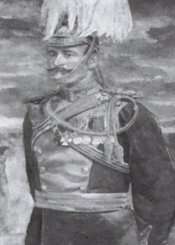Paul Aloysius Kenna
| Paul Aloysius Kenna | |
|---|---|
 | |
| Born |
16 August 1862 Everton, Liverpool |
| Died |
30 August 1915 (aged 53) Suvla Bay, Turkey |
| Allegiance |
|
| Service/branch |
|
| Years of service | –1915 † |
| Rank | Brigadier General |
| Unit |
21st Lancers 3rd (Nottinghamshire and Derbyshire) Mounted Brigade[1] |
| Battles/wars |
Mahdist War Second Boer War Third Somaliland Expedition World War I |
| Awards | Victoria Cross, Distinguished Service Order |
| Relations | Montagu Arthur Bertie, 7th Earl of Abingdon (father-in-law), Simon Mangan, Patrick Leonard, Nicolas Tindal-Carill-Worsley |
| Other work | Olympic horserider |
Brigadier General Paul Aloysius Kenna, VC, DSO (Irish: Pól Lughaidh Mac Cionaoith; 16 August 1862 – 30 August 1915) was an English-born British Army officer of Irish descent and recipient of the Victoria Cross (VC), the highest and most prestigious award for gallantry in the face of the enemy that could be awarded to British and British Empire forces.
Background
He was the son of James Kenna, of Liverpool, who was descended from a family of minor gentry from County Meath. Kenna was educated at St.Augustine's College[2] in Ramsgate, Stonyhurst College[3] and St. Francis Xavier College in Liverpool - he is honoured in a memorial which can be seen in the main hall of the current college site in Beaconsfield Road, Liverpool and by a plaque and a portrait (see side-bar) at Stonyhurst.
Military service and Victoria Cross
Kenna was 36 years old, and a captain in the 21st Lancers (Empress of India's) during the Sudan Campaign when the following deed took place for which he was awarded the VC:
- On 2 September 1898, at the Battle of Omdurman, Sudan, when a major of the 21st Lancers was in danger, as his horse had been shot in the charge, Captain Kenna took the major up on his own horse, to a place of safety. After the charge Captain Kenna returned to help Lieutenant De Montmorency who was trying to recover the body of an officer who had been killed.[4][5]
He later served in the Second Boer War in South Africa 1899–1900, was promoted a brevet major on 29 November 1900,[6] and received the substantive rank of captain on 27 January 1902.[7] For his service during the war, he was appointed a Companion of the Distinguished Service Order (DSO) in the South Africa Honours list published on 26 June 1902.[8] Following the end of the war that month Kenna returned to the United Kingdom in the SS Dunottar Castle, which arrived at Southampton in July 1902.[9] He received the substantive rank of major on his appointment to lead a Mounted infantry flying column in Somaliland in September 1902. In September 1910 he retired with the rank of Colonel from the Regular Army but in April 1912 was appointed to command the Notts and Derby (Yeomanry) Mounted Brigade and on the outbreak of war was appointed Brigadier-General.[10]
Olympics
He competed in the 1912 Summer Olympics for Great Britain as a horse rider. He did not finish the Individual eventing (Military) competition, also the British team did not finish the team event. In the individual jumping event he finished 27th.[11]
World War I
He was killed in action at Suvla, Turkey during the Battle of Gallipoli on 30 August 1915, aged 53 and is buried in Lala Baba Cemetery.[12][13]
His VC is on display in The Queen's Royal Lancers and Nottinghamshire Yeomanry Museum in Thoresby Park, Nottinghamshire.
Family
Kenna married Lady Cecil Bertie, daughter of the 7th Earl of Abingdon. He married, secondly, Angela Mary, daughter of Herbert Hibbert. They had one daughter, Kathleen (died 1998) [14]
His first cousin, Margaret (née) Larkin (granddaughter of his grandfather Patrick Kenna) married Simon Mangan, HM Lieutenant for Co. Meath. Their grandson was Group Captain Nicolas Tindal-Carill-Worsley.
See also
References
- Notes
- ↑ Davies & Maddocks 1995, p. 80
- ↑ "General Paul Kenna, V.c. - from the Tablet Archive". archive.thetablet.co.uk. Retrieved 2016-11-14.
- ↑ "General Paul Kenna, V.c. • - from the Tablet Archive". archive.thetablet.co.uk. Retrieved 2016-11-14.
- ↑ The London Gazette: no. 27490. p. 6897. 31 October 1902. Retrieved 31 March 2015.
- ↑ Brighton, Terry, The Last Charge: the 21st Lancers and the Battle of Omdurman. Marlborough: Crowood, 1998. ISBN 1-86126-189-6.
- ↑ The London Gazette: no. 27359. p. 6303. 27 September 1901.
- ↑ The London Gazette: no. 27403. p. 716. 4 February 1902.
- ↑ The London Gazette: (Supplement) no. 27448. pp. 4191–4192. 26 June 1902.
- ↑ "The Army in South Africa - Troops returning home". The Times (36814). London. 8 July 1902. p. 11.
- ↑ Kirby & Walsh pp 52 and 54.
- ↑ "Paul Kenna". Sports Reference. Retrieved 3 August 2015.
- ↑ CWGC entry
- ↑ "Olympians Who Were Killed or Missing in Action or Died as a Result of War". Sports Reference. Retrieved 3 August 2015.
- ↑ Burke, 'Irish Family Records' (1978), Burke's Peerage (2005), see 'The Peerage' site.
- Bibliography
- Davies, Frank; Maddocks, Graham (1995). Bloody Red Tabs. Leo Cooper. ISBN 0-85052-463-6.
- Doherty, Richard; Truesdale, David (2000). Irish Winners of the Victoria Cross.
- Harvey, David (1999). Monuments to Courage.
- Murphy, James (2008). Liverpool VCs. Pen and Sword Books.
- The Register of the Victoria Cross. This England. 1997.
- Kirby, H.L. & Walsh, R Raymond: The Seven V.C.s of Stonyhurst College (1987) THCL Books ISBN 0-948494-04-2